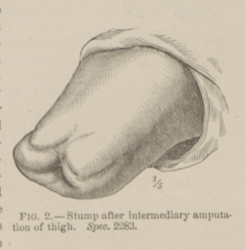Title: Schatt, H.
Source text: The Medical and Surgical History of the War of the Rebellion. (1861-65.), Part 3, Volume 2 (Washington, DC: Government Printing Office, 1883), 17.
Civil War Washington ID: med.d2e647
TEI/XML: med.d2e647.xml
CASE 26.—Corporal H. Schatt, Co. H, 64th New York, aged 30 years, was wounded at Hatcher's Run, March 25, 1865, and was admitted to the field hospital of the 1st division, Second Corps, where Surgeon F. M. Hammond, 126th New York, noted "a shot wound of the leg." On the following day the man was sent to City Point and thence to Washington. Assistant Surgeon H. Allen, U. S. A., reported his admission to Mount Pleasant Hospital April 2d, and contributed the following history: "Gunshot wound of left lower extremity, ball passing through popliteal space from without inward, injuring the popliteal artery. When admitted the patient's pulse was small, sharp, and fast; face pale and tongue coated. His toes were of a bluish tint, and the foot was covered with bluish and yellowish purple spots. The entire leg was greatly swollen and the superficial veins enlarged; the small veins of the lower third of the thigh, on the external surface, were somewhat discolored, and the integument was assuming a yellowish color. The limb was amputated at the lower third of the thigh, on the day of admission, by Acting Assistant Surgeon H. Craft. The operation was performed by the circular method, very little blood being lost. Two double ligatures were applied to the femoral and four to the branches. The anæsthetic consisted of equal parts of æther and chloroform. After the operation, cold-water dressings were applied, and a stimulating course adopted. The ligatures came away on the sixth and seventh days. On May 10th, there were symptoms of the femur exfoliating. The stump was nearly healed, when a collection of pus formed around the bone, and to give exit to it an incision was made just above the end of the stump. This was kept open by a tent and the stump encouraged to heal. Simple dressings were continued, and the tonic and stimulating course was persevered in. The exfoliating process steadily progressed up to June 19th, when a sequestrum was removed which proved to be nine inches long and was nearly a perfect shaft, extending nearly or quite to the trochanter major. It had only been partially destroyed on its under surface, and a new shaft of bone had formed around it. The stimulants and tonics were now increased, with nourishing diet, and by June 30th the patient was progressing favorably." The sequestrum was forwarded to the Army Medical Museum by Dr. Allen, and is represented in the annexed cut (FIG. 1). The patient was subsequently transferred to Rochester, and ultimately discharged from Ira Harris Hospital, Albany, September 25, 1865. Assistant Surgeon J. H. Armsby, U. S. V., contributed a cast of the stump (Cat. Surg. Sect., 1866, p. 554), which shows the inferior portion to be baggy, and a deep and poorly healed cicatrix at that point, caused by loss of substance over the bone (FIG. 2). Examiner G. W. Cook, of Syracuse, N. Y., July 9, 1873, certified: "Tenderness of stump and slight covering over end of bone. He does not, nor can he, wear an artificial limb." The pensioner was paid June 4, 1876.

